IT Infrastructure Management Report: Concepts, Analysis, and Problems
VerifiedAdded on 2023/06/06
|13
|2349
|286
Report
AI Summary
This report delves into various aspects of IT infrastructure management, commencing with an overview of Electronic Records Management (ERM), Business Intelligence (BI), Business Analytics (BA), Data and Text Mining, Big Data Analytics, Enterprise Architecture (EA), Management Information Systems (MIS), Data Life Cycles, and Cloud Computing. The report then explores the application of text and data mining in business, emphasizing customer engagement, business decision-making, and risk detection. It further examines the challenges of cloud computing, particularly insider threats and data breaching, followed by an analysis of the design and implementation of an Executive Information System (EIS), including issues, causes, and improvements. The report concludes by discussing the significance of processing Point of Sale (POS) data, customer experience strategies, the importance of trusted data views, the Black Book Model, and its strategic advantages within the Coca-Cola Company. The report provides a comprehensive overview of the concepts and applications within IT infrastructure management.
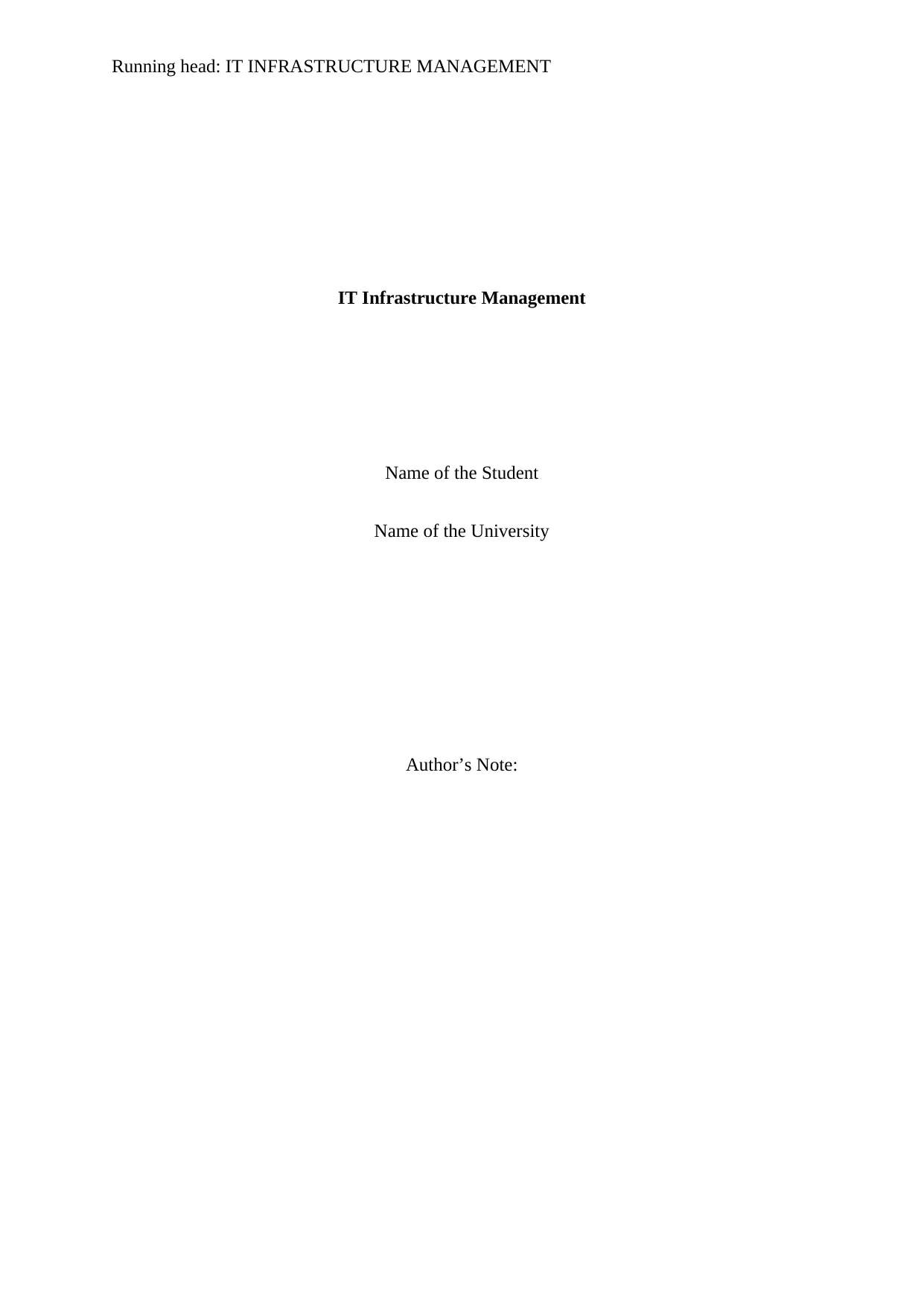
Running head: IT INFRASTRUCTURE MANAGEMENT
IT Infrastructure Management
Name of the Student
Name of the University
Author’s Note:
IT Infrastructure Management
Name of the Student
Name of the University
Author’s Note:
Paraphrase This Document
Need a fresh take? Get an instant paraphrase of this document with our AI Paraphraser

1
IT INFRASTRUCTURE MANAGEMENT
Table of Contents
Question 1..................................................................................................................................2
Question 2..................................................................................................................................5
Question 3..................................................................................................................................6
Question 4..................................................................................................................................8
Question 5..................................................................................................................................9
References................................................................................................................................10
IT INFRASTRUCTURE MANAGEMENT
Table of Contents
Question 1..................................................................................................................................2
Question 2..................................................................................................................................5
Question 3..................................................................................................................................6
Question 4..................................................................................................................................8
Question 5..................................................................................................................................9
References................................................................................................................................10
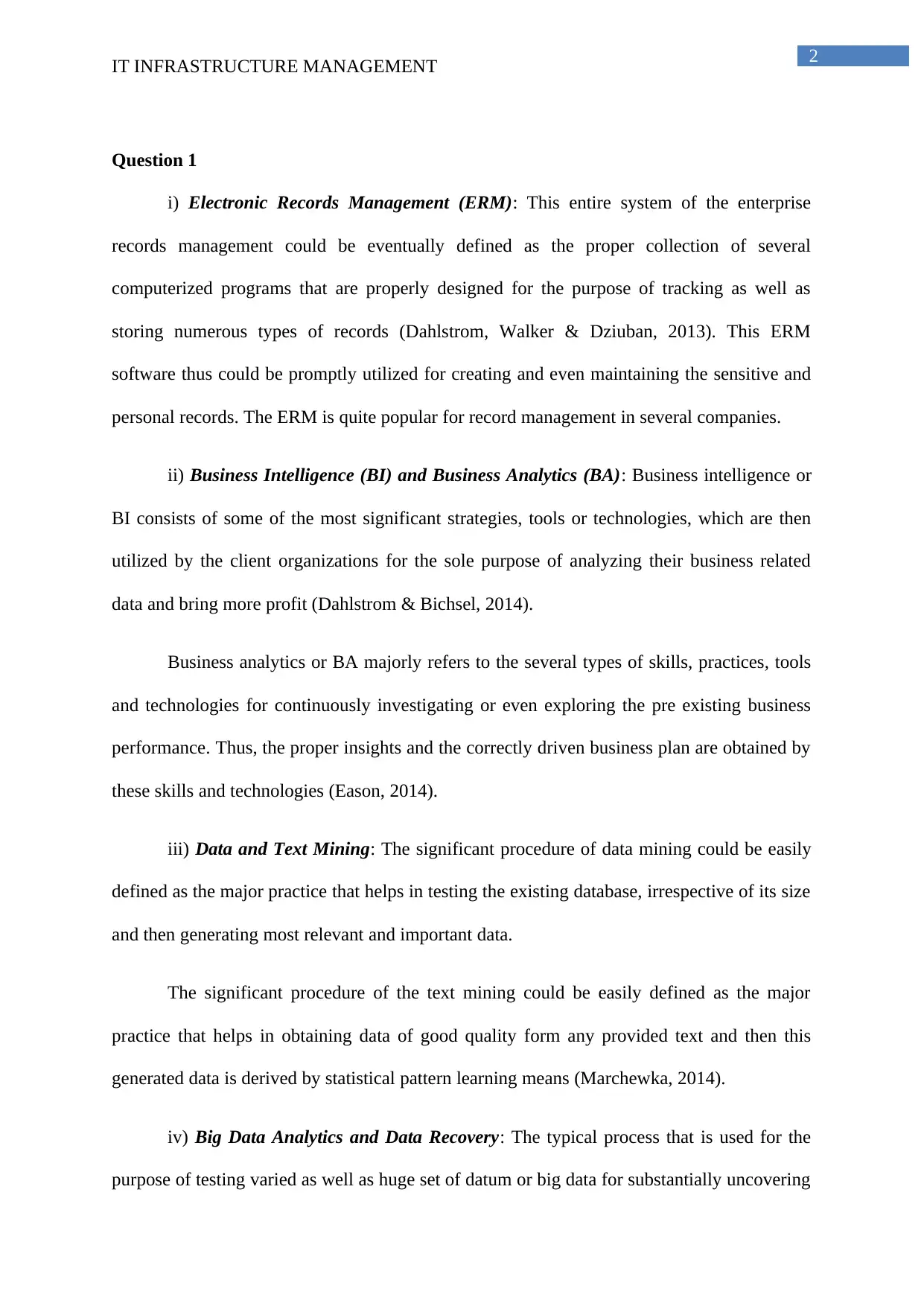
2
IT INFRASTRUCTURE MANAGEMENT
Question 1
i) Electronic Records Management (ERM): This entire system of the enterprise
records management could be eventually defined as the proper collection of several
computerized programs that are properly designed for the purpose of tracking as well as
storing numerous types of records (Dahlstrom, Walker & Dziuban, 2013). This ERM
software thus could be promptly utilized for creating and even maintaining the sensitive and
personal records. The ERM is quite popular for record management in several companies.
ii) Business Intelligence (BI) and Business Analytics (BA): Business intelligence or
BI consists of some of the most significant strategies, tools or technologies, which are then
utilized by the client organizations for the sole purpose of analyzing their business related
data and bring more profit (Dahlstrom & Bichsel, 2014).
Business analytics or BA majorly refers to the several types of skills, practices, tools
and technologies for continuously investigating or even exploring the pre existing business
performance. Thus, the proper insights and the correctly driven business plan are obtained by
these skills and technologies (Eason, 2014).
iii) Data and Text Mining: The significant procedure of data mining could be easily
defined as the major practice that helps in testing the existing database, irrespective of its size
and then generating most relevant and important data.
The significant procedure of the text mining could be easily defined as the major
practice that helps in obtaining data of good quality form any provided text and then this
generated data is derived by statistical pattern learning means (Marchewka, 2014).
iv) Big Data Analytics and Data Recovery: The typical process that is used for the
purpose of testing varied as well as huge set of datum or big data for substantially uncovering
IT INFRASTRUCTURE MANAGEMENT
Question 1
i) Electronic Records Management (ERM): This entire system of the enterprise
records management could be eventually defined as the proper collection of several
computerized programs that are properly designed for the purpose of tracking as well as
storing numerous types of records (Dahlstrom, Walker & Dziuban, 2013). This ERM
software thus could be promptly utilized for creating and even maintaining the sensitive and
personal records. The ERM is quite popular for record management in several companies.
ii) Business Intelligence (BI) and Business Analytics (BA): Business intelligence or
BI consists of some of the most significant strategies, tools or technologies, which are then
utilized by the client organizations for the sole purpose of analyzing their business related
data and bring more profit (Dahlstrom & Bichsel, 2014).
Business analytics or BA majorly refers to the several types of skills, practices, tools
and technologies for continuously investigating or even exploring the pre existing business
performance. Thus, the proper insights and the correctly driven business plan are obtained by
these skills and technologies (Eason, 2014).
iii) Data and Text Mining: The significant procedure of data mining could be easily
defined as the major practice that helps in testing the existing database, irrespective of its size
and then generating most relevant and important data.
The significant procedure of the text mining could be easily defined as the major
practice that helps in obtaining data of good quality form any provided text and then this
generated data is derived by statistical pattern learning means (Marchewka, 2014).
iv) Big Data Analytics and Data Recovery: The typical process that is used for the
purpose of testing varied as well as huge set of datum or big data for substantially uncovering
⊘ This is a preview!⊘
Do you want full access?
Subscribe today to unlock all pages.

Trusted by 1+ million students worldwide
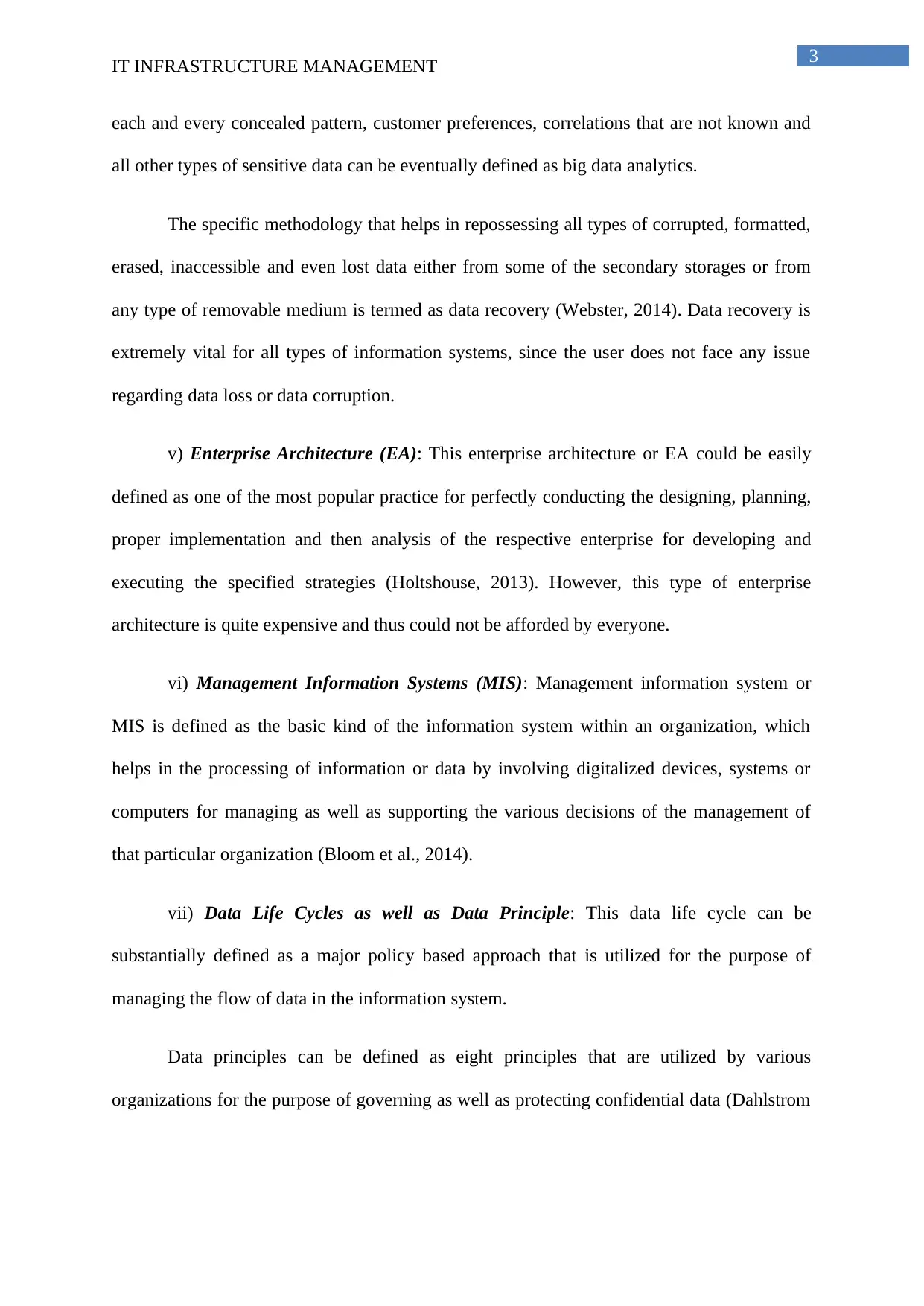
3
IT INFRASTRUCTURE MANAGEMENT
each and every concealed pattern, customer preferences, correlations that are not known and
all other types of sensitive data can be eventually defined as big data analytics.
The specific methodology that helps in repossessing all types of corrupted, formatted,
erased, inaccessible and even lost data either from some of the secondary storages or from
any type of removable medium is termed as data recovery (Webster, 2014). Data recovery is
extremely vital for all types of information systems, since the user does not face any issue
regarding data loss or data corruption.
v) Enterprise Architecture (EA): This enterprise architecture or EA could be easily
defined as one of the most popular practice for perfectly conducting the designing, planning,
proper implementation and then analysis of the respective enterprise for developing and
executing the specified strategies (Holtshouse, 2013). However, this type of enterprise
architecture is quite expensive and thus could not be afforded by everyone.
vi) Management Information Systems (MIS): Management information system or
MIS is defined as the basic kind of the information system within an organization, which
helps in the processing of information or data by involving digitalized devices, systems or
computers for managing as well as supporting the various decisions of the management of
that particular organization (Bloom et al., 2014).
vii) Data Life Cycles as well as Data Principle: This data life cycle can be
substantially defined as a major policy based approach that is utilized for the purpose of
managing the flow of data in the information system.
Data principles can be defined as eight principles that are utilized by various
organizations for the purpose of governing as well as protecting confidential data (Dahlstrom
IT INFRASTRUCTURE MANAGEMENT
each and every concealed pattern, customer preferences, correlations that are not known and
all other types of sensitive data can be eventually defined as big data analytics.
The specific methodology that helps in repossessing all types of corrupted, formatted,
erased, inaccessible and even lost data either from some of the secondary storages or from
any type of removable medium is termed as data recovery (Webster, 2014). Data recovery is
extremely vital for all types of information systems, since the user does not face any issue
regarding data loss or data corruption.
v) Enterprise Architecture (EA): This enterprise architecture or EA could be easily
defined as one of the most popular practice for perfectly conducting the designing, planning,
proper implementation and then analysis of the respective enterprise for developing and
executing the specified strategies (Holtshouse, 2013). However, this type of enterprise
architecture is quite expensive and thus could not be afforded by everyone.
vi) Management Information Systems (MIS): Management information system or
MIS is defined as the basic kind of the information system within an organization, which
helps in the processing of information or data by involving digitalized devices, systems or
computers for managing as well as supporting the various decisions of the management of
that particular organization (Bloom et al., 2014).
vii) Data Life Cycles as well as Data Principle: This data life cycle can be
substantially defined as a major policy based approach that is utilized for the purpose of
managing the flow of data in the information system.
Data principles can be defined as eight principles that are utilized by various
organizations for the purpose of governing as well as protecting confidential data (Dahlstrom
Paraphrase This Document
Need a fresh take? Get an instant paraphrase of this document with our AI Paraphraser
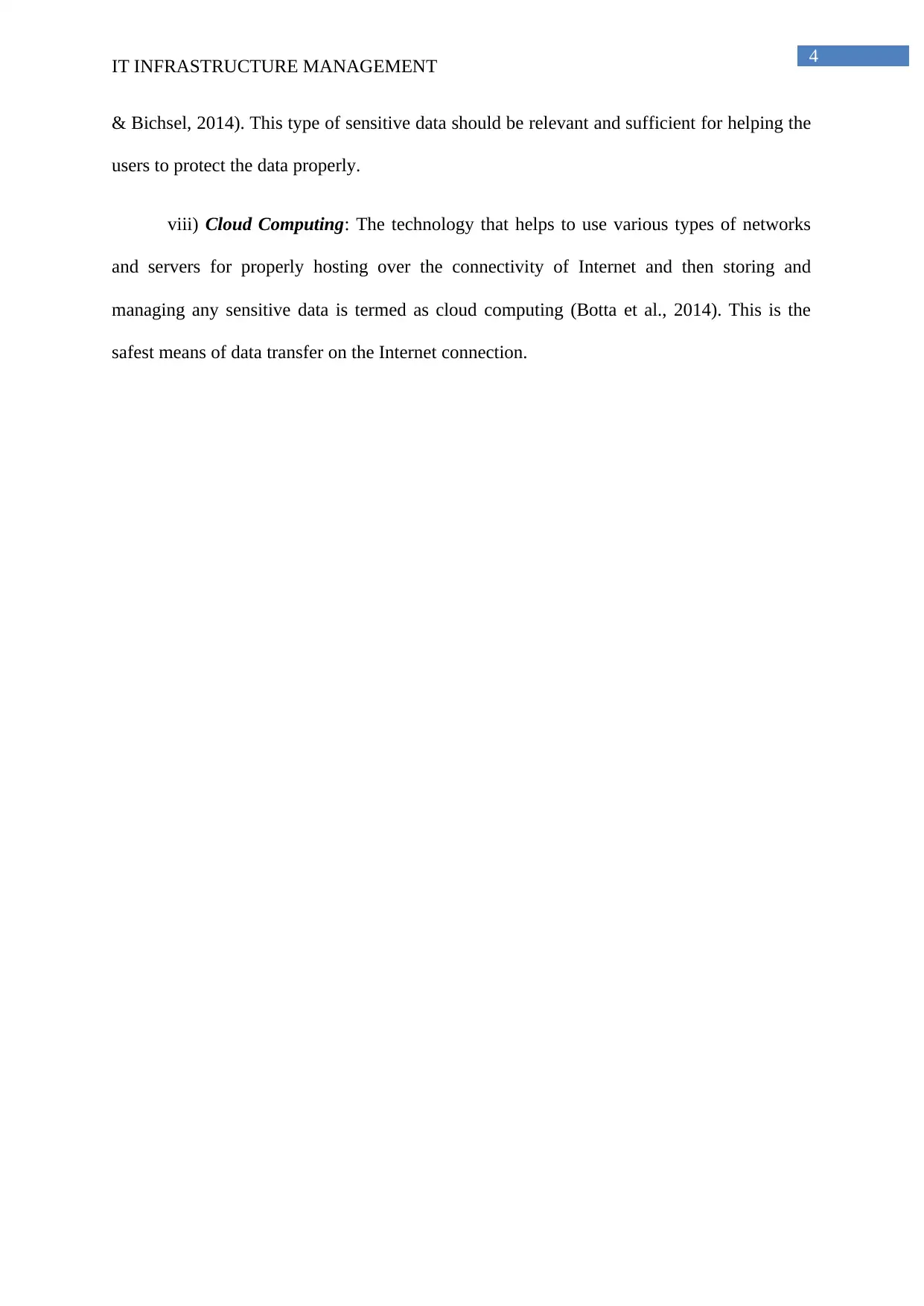
4
IT INFRASTRUCTURE MANAGEMENT
& Bichsel, 2014). This type of sensitive data should be relevant and sufficient for helping the
users to protect the data properly.
viii) Cloud Computing: The technology that helps to use various types of networks
and servers for properly hosting over the connectivity of Internet and then storing and
managing any sensitive data is termed as cloud computing (Botta et al., 2014). This is the
safest means of data transfer on the Internet connection.
IT INFRASTRUCTURE MANAGEMENT
& Bichsel, 2014). This type of sensitive data should be relevant and sufficient for helping the
users to protect the data properly.
viii) Cloud Computing: The technology that helps to use various types of networks
and servers for properly hosting over the connectivity of Internet and then storing and
managing any sensitive data is termed as cloud computing (Botta et al., 2014). This is the
safest means of data transfer on the Internet connection.

5
IT INFRASTRUCTURE MANAGEMENT
Question 2
The text mining and the data mining helps to perfectly create the respective values in
any typical business or organization (Eason, 2014). There are several important
methodologies for this text mining and data mining processes and these are as follows:
i) Engagement of the Customers: The first and the foremost methodology of the text
mining as well as data mining process is the proper customers’ engagement. The customer
relationship management or CRM is considered as one of the most important or significant
requirement that makes any business quite popular for the customers and hence various other
technologies and techniques are also applied here (Holtshouse, 2013).
ii) Better Decisions of Business: The processes of text mining and data mining are
majorly responsible for the helping out of the organization by providing proper insights in the
huge range of sources and documents.
iii) Risks, Compliances as well as Threat Detection: There is perfect analysis of risks
required in all the sectors of a company and if this is not done, it could be highly threatening
for the organization (Marchewka, 2014). Within the financial organizations, text mining is
being utilized for the purpose of detecting several issues of the compliances and thus warning
is provided to them to stop such actions.
These previously mentioned methods of text and data mining depict that these
processes can easily create business value in all organizations.
IT INFRASTRUCTURE MANAGEMENT
Question 2
The text mining and the data mining helps to perfectly create the respective values in
any typical business or organization (Eason, 2014). There are several important
methodologies for this text mining and data mining processes and these are as follows:
i) Engagement of the Customers: The first and the foremost methodology of the text
mining as well as data mining process is the proper customers’ engagement. The customer
relationship management or CRM is considered as one of the most important or significant
requirement that makes any business quite popular for the customers and hence various other
technologies and techniques are also applied here (Holtshouse, 2013).
ii) Better Decisions of Business: The processes of text mining and data mining are
majorly responsible for the helping out of the organization by providing proper insights in the
huge range of sources and documents.
iii) Risks, Compliances as well as Threat Detection: There is perfect analysis of risks
required in all the sectors of a company and if this is not done, it could be highly threatening
for the organization (Marchewka, 2014). Within the financial organizations, text mining is
being utilized for the purpose of detecting several issues of the compliances and thus warning
is provided to them to stop such actions.
These previously mentioned methods of text and data mining depict that these
processes can easily create business value in all organizations.
⊘ This is a preview!⊘
Do you want full access?
Subscribe today to unlock all pages.

Trusted by 1+ million students worldwide
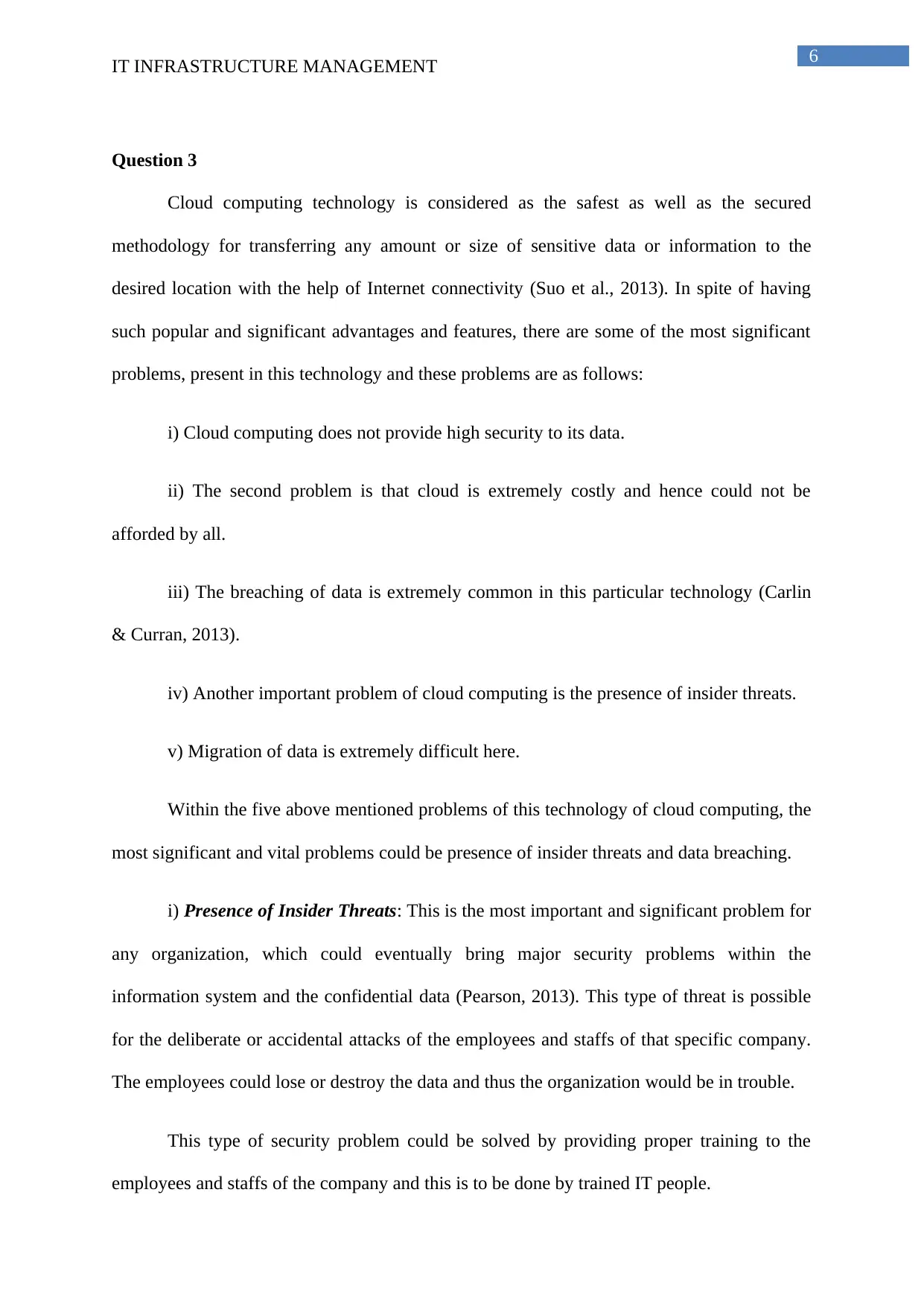
6
IT INFRASTRUCTURE MANAGEMENT
Question 3
Cloud computing technology is considered as the safest as well as the secured
methodology for transferring any amount or size of sensitive data or information to the
desired location with the help of Internet connectivity (Suo et al., 2013). In spite of having
such popular and significant advantages and features, there are some of the most significant
problems, present in this technology and these problems are as follows:
i) Cloud computing does not provide high security to its data.
ii) The second problem is that cloud is extremely costly and hence could not be
afforded by all.
iii) The breaching of data is extremely common in this particular technology (Carlin
& Curran, 2013).
iv) Another important problem of cloud computing is the presence of insider threats.
v) Migration of data is extremely difficult here.
Within the five above mentioned problems of this technology of cloud computing, the
most significant and vital problems could be presence of insider threats and data breaching.
i) Presence of Insider Threats: This is the most important and significant problem for
any organization, which could eventually bring major security problems within the
information system and the confidential data (Pearson, 2013). This type of threat is possible
for the deliberate or accidental attacks of the employees and staffs of that specific company.
The employees could lose or destroy the data and thus the organization would be in trouble.
This type of security problem could be solved by providing proper training to the
employees and staffs of the company and this is to be done by trained IT people.
IT INFRASTRUCTURE MANAGEMENT
Question 3
Cloud computing technology is considered as the safest as well as the secured
methodology for transferring any amount or size of sensitive data or information to the
desired location with the help of Internet connectivity (Suo et al., 2013). In spite of having
such popular and significant advantages and features, there are some of the most significant
problems, present in this technology and these problems are as follows:
i) Cloud computing does not provide high security to its data.
ii) The second problem is that cloud is extremely costly and hence could not be
afforded by all.
iii) The breaching of data is extremely common in this particular technology (Carlin
& Curran, 2013).
iv) Another important problem of cloud computing is the presence of insider threats.
v) Migration of data is extremely difficult here.
Within the five above mentioned problems of this technology of cloud computing, the
most significant and vital problems could be presence of insider threats and data breaching.
i) Presence of Insider Threats: This is the most important and significant problem for
any organization, which could eventually bring major security problems within the
information system and the confidential data (Pearson, 2013). This type of threat is possible
for the deliberate or accidental attacks of the employees and staffs of that specific company.
The employees could lose or destroy the data and thus the organization would be in trouble.
This type of security problem could be solved by providing proper training to the
employees and staffs of the company and this is to be done by trained IT people.
Paraphrase This Document
Need a fresh take? Get an instant paraphrase of this document with our AI Paraphraser
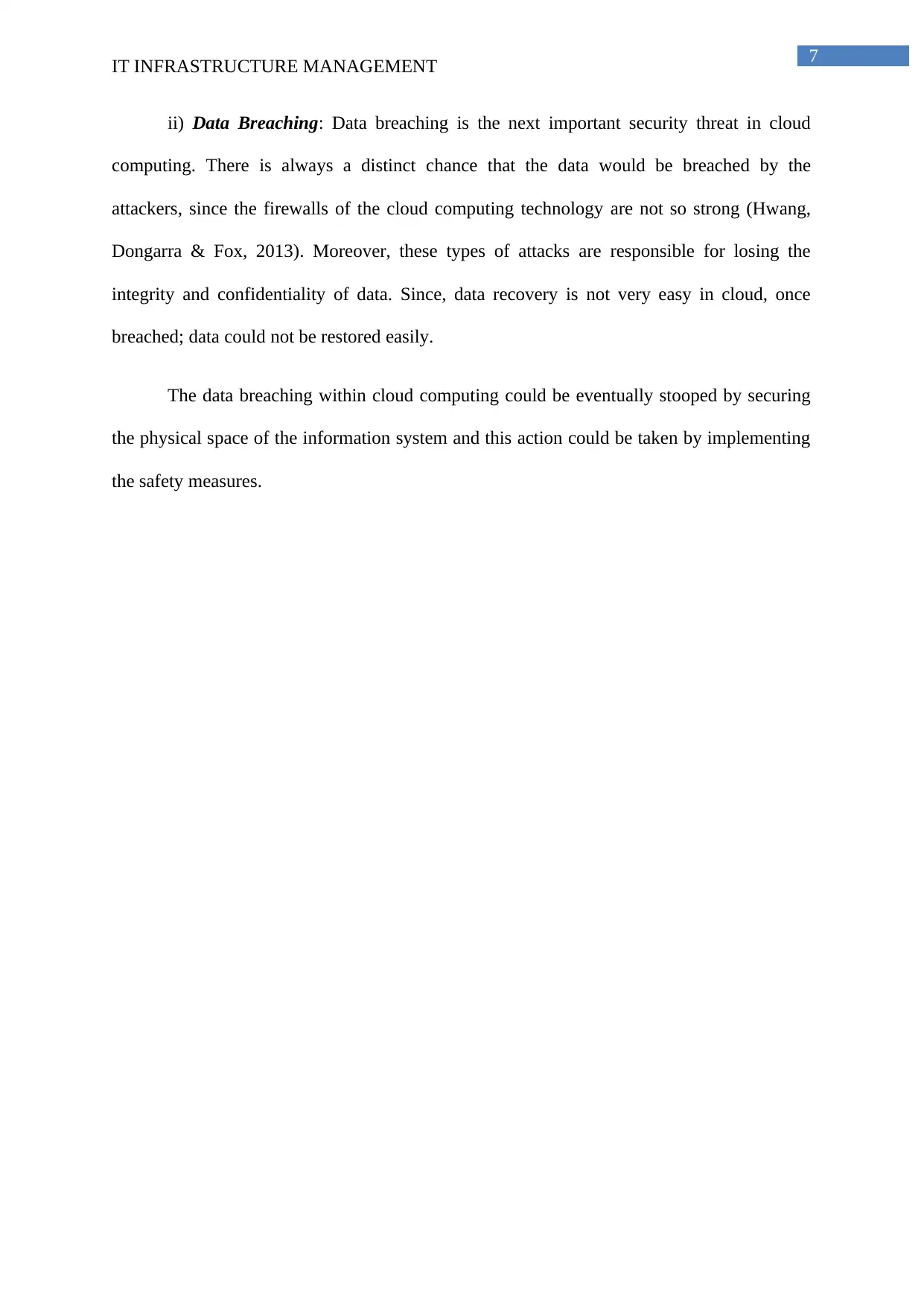
7
IT INFRASTRUCTURE MANAGEMENT
ii) Data Breaching: Data breaching is the next important security threat in cloud
computing. There is always a distinct chance that the data would be breached by the
attackers, since the firewalls of the cloud computing technology are not so strong (Hwang,
Dongarra & Fox, 2013). Moreover, these types of attacks are responsible for losing the
integrity and confidentiality of data. Since, data recovery is not very easy in cloud, once
breached; data could not be restored easily.
The data breaching within cloud computing could be eventually stooped by securing
the physical space of the information system and this action could be taken by implementing
the safety measures.
IT INFRASTRUCTURE MANAGEMENT
ii) Data Breaching: Data breaching is the next important security threat in cloud
computing. There is always a distinct chance that the data would be breached by the
attackers, since the firewalls of the cloud computing technology are not so strong (Hwang,
Dongarra & Fox, 2013). Moreover, these types of attacks are responsible for losing the
integrity and confidentiality of data. Since, data recovery is not very easy in cloud, once
breached; data could not be restored easily.
The data breaching within cloud computing could be eventually stooped by securing
the physical space of the information system and this action could be taken by implementing
the safety measures.

8
IT INFRASTRUCTURE MANAGEMENT
Question 4
i) Reason for Designing and Implementing EIS: EIS was designed and then
implemented for providing internal as well as external data to the senior manager within the
company. The other reason was to identify the key performance indicators or KPIs for this
company.
ii) Issues with EIS: Some of the major issues were present with the designing and
implementation of EIS. The most important issue with EIS was that about half of the total
information was not available or accessible by this system. The second issue with EIS was
that the confidential data were not being accessed by the users at any cost. This was mainly
because of the location complexities. The different time frames were another issue for sales
revenue collection by this system.
iii) Causes for the EIS problems: The most important cause of EIS failure was that
architecture was not designed perfectly for any customized report. The user interfaces were
extremely complicated and thus the executives could not review KPIs.
iv) CIO Improved EIS: The CIO then designed and implemented a new EIS with the
employees and hence new procedures and policies were implemented for standardizing data
formats.
v) Advantages of new IT Architecture: The first benefit was that report modification
was easily done and the second benefit was that time consumption is extremely less and thus
expensive ad-hoc analysis is eliminated.
vi) Benefits of Data Governance: Management of the data was easier and the second
benefit was that accuracy was checked as per rules and standards.
IT INFRASTRUCTURE MANAGEMENT
Question 4
i) Reason for Designing and Implementing EIS: EIS was designed and then
implemented for providing internal as well as external data to the senior manager within the
company. The other reason was to identify the key performance indicators or KPIs for this
company.
ii) Issues with EIS: Some of the major issues were present with the designing and
implementation of EIS. The most important issue with EIS was that about half of the total
information was not available or accessible by this system. The second issue with EIS was
that the confidential data were not being accessed by the users at any cost. This was mainly
because of the location complexities. The different time frames were another issue for sales
revenue collection by this system.
iii) Causes for the EIS problems: The most important cause of EIS failure was that
architecture was not designed perfectly for any customized report. The user interfaces were
extremely complicated and thus the executives could not review KPIs.
iv) CIO Improved EIS: The CIO then designed and implemented a new EIS with the
employees and hence new procedures and policies were implemented for standardizing data
formats.
v) Advantages of new IT Architecture: The first benefit was that report modification
was easily done and the second benefit was that time consumption is extremely less and thus
expensive ad-hoc analysis is eliminated.
vi) Benefits of Data Governance: Management of the data was easier and the second
benefit was that accuracy was checked as per rules and standards.
⊘ This is a preview!⊘
Do you want full access?
Subscribe today to unlock all pages.

Trusted by 1+ million students worldwide

9
IT INFRASTRUCTURE MANAGEMENT
IT INFRASTRUCTURE MANAGEMENT
Paraphrase This Document
Need a fresh take? Get an instant paraphrase of this document with our AI Paraphraser
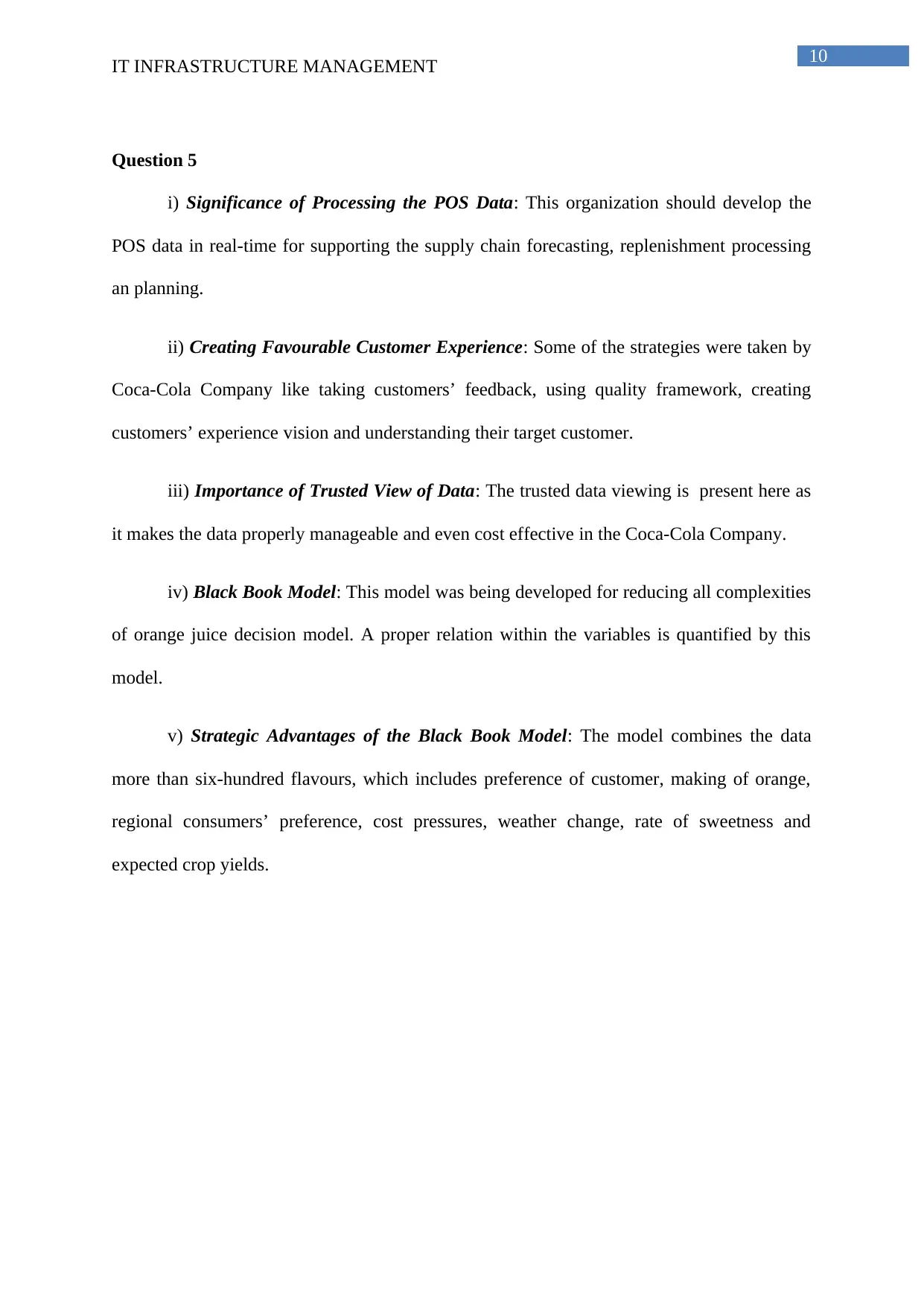
10
IT INFRASTRUCTURE MANAGEMENT
Question 5
i) Significance of Processing the POS Data: This organization should develop the
POS data in real-time for supporting the supply chain forecasting, replenishment processing
an planning.
ii) Creating Favourable Customer Experience: Some of the strategies were taken by
Coca-Cola Company like taking customers’ feedback, using quality framework, creating
customers’ experience vision and understanding their target customer.
iii) Importance of Trusted View of Data: The trusted data viewing is present here as
it makes the data properly manageable and even cost effective in the Coca-Cola Company.
iv) Black Book Model: This model was being developed for reducing all complexities
of orange juice decision model. A proper relation within the variables is quantified by this
model.
v) Strategic Advantages of the Black Book Model: The model combines the data
more than six-hundred flavours, which includes preference of customer, making of orange,
regional consumers’ preference, cost pressures, weather change, rate of sweetness and
expected crop yields.
IT INFRASTRUCTURE MANAGEMENT
Question 5
i) Significance of Processing the POS Data: This organization should develop the
POS data in real-time for supporting the supply chain forecasting, replenishment processing
an planning.
ii) Creating Favourable Customer Experience: Some of the strategies were taken by
Coca-Cola Company like taking customers’ feedback, using quality framework, creating
customers’ experience vision and understanding their target customer.
iii) Importance of Trusted View of Data: The trusted data viewing is present here as
it makes the data properly manageable and even cost effective in the Coca-Cola Company.
iv) Black Book Model: This model was being developed for reducing all complexities
of orange juice decision model. A proper relation within the variables is quantified by this
model.
v) Strategic Advantages of the Black Book Model: The model combines the data
more than six-hundred flavours, which includes preference of customer, making of orange,
regional consumers’ preference, cost pressures, weather change, rate of sweetness and
expected crop yields.
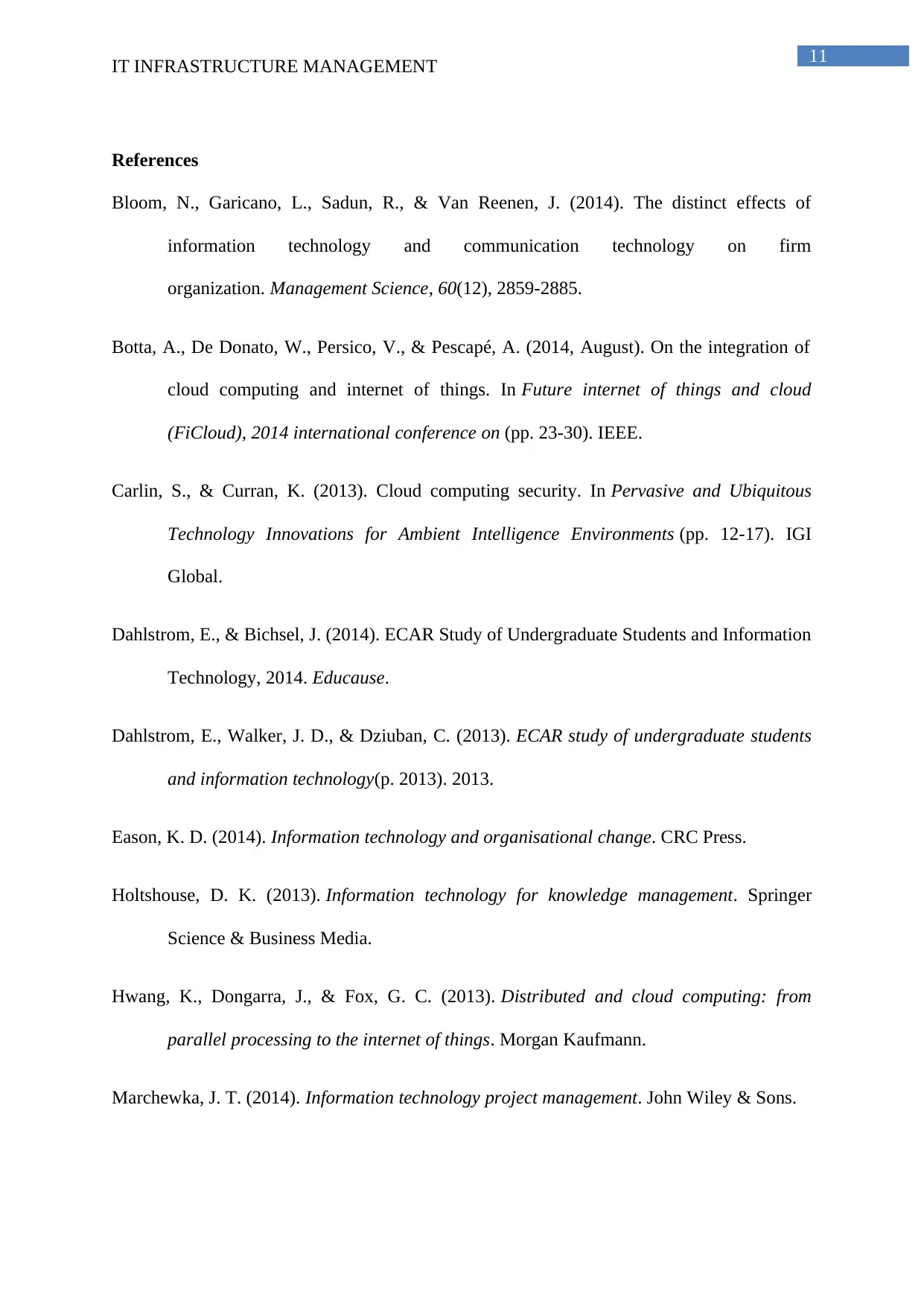
11
IT INFRASTRUCTURE MANAGEMENT
References
Bloom, N., Garicano, L., Sadun, R., & Van Reenen, J. (2014). The distinct effects of
information technology and communication technology on firm
organization. Management Science, 60(12), 2859-2885.
Botta, A., De Donato, W., Persico, V., & Pescapé, A. (2014, August). On the integration of
cloud computing and internet of things. In Future internet of things and cloud
(FiCloud), 2014 international conference on (pp. 23-30). IEEE.
Carlin, S., & Curran, K. (2013). Cloud computing security. In Pervasive and Ubiquitous
Technology Innovations for Ambient Intelligence Environments (pp. 12-17). IGI
Global.
Dahlstrom, E., & Bichsel, J. (2014). ECAR Study of Undergraduate Students and Information
Technology, 2014. Educause.
Dahlstrom, E., Walker, J. D., & Dziuban, C. (2013). ECAR study of undergraduate students
and information technology(p. 2013). 2013.
Eason, K. D. (2014). Information technology and organisational change. CRC Press.
Holtshouse, D. K. (2013). Information technology for knowledge management. Springer
Science & Business Media.
Hwang, K., Dongarra, J., & Fox, G. C. (2013). Distributed and cloud computing: from
parallel processing to the internet of things. Morgan Kaufmann.
Marchewka, J. T. (2014). Information technology project management. John Wiley & Sons.
IT INFRASTRUCTURE MANAGEMENT
References
Bloom, N., Garicano, L., Sadun, R., & Van Reenen, J. (2014). The distinct effects of
information technology and communication technology on firm
organization. Management Science, 60(12), 2859-2885.
Botta, A., De Donato, W., Persico, V., & Pescapé, A. (2014, August). On the integration of
cloud computing and internet of things. In Future internet of things and cloud
(FiCloud), 2014 international conference on (pp. 23-30). IEEE.
Carlin, S., & Curran, K. (2013). Cloud computing security. In Pervasive and Ubiquitous
Technology Innovations for Ambient Intelligence Environments (pp. 12-17). IGI
Global.
Dahlstrom, E., & Bichsel, J. (2014). ECAR Study of Undergraduate Students and Information
Technology, 2014. Educause.
Dahlstrom, E., Walker, J. D., & Dziuban, C. (2013). ECAR study of undergraduate students
and information technology(p. 2013). 2013.
Eason, K. D. (2014). Information technology and organisational change. CRC Press.
Holtshouse, D. K. (2013). Information technology for knowledge management. Springer
Science & Business Media.
Hwang, K., Dongarra, J., & Fox, G. C. (2013). Distributed and cloud computing: from
parallel processing to the internet of things. Morgan Kaufmann.
Marchewka, J. T. (2014). Information technology project management. John Wiley & Sons.
⊘ This is a preview!⊘
Do you want full access?
Subscribe today to unlock all pages.

Trusted by 1+ million students worldwide
1 out of 13
Related Documents
Your All-in-One AI-Powered Toolkit for Academic Success.
+13062052269
info@desklib.com
Available 24*7 on WhatsApp / Email
![[object Object]](/_next/static/media/star-bottom.7253800d.svg)
Unlock your academic potential
Copyright © 2020–2025 A2Z Services. All Rights Reserved. Developed and managed by ZUCOL.


